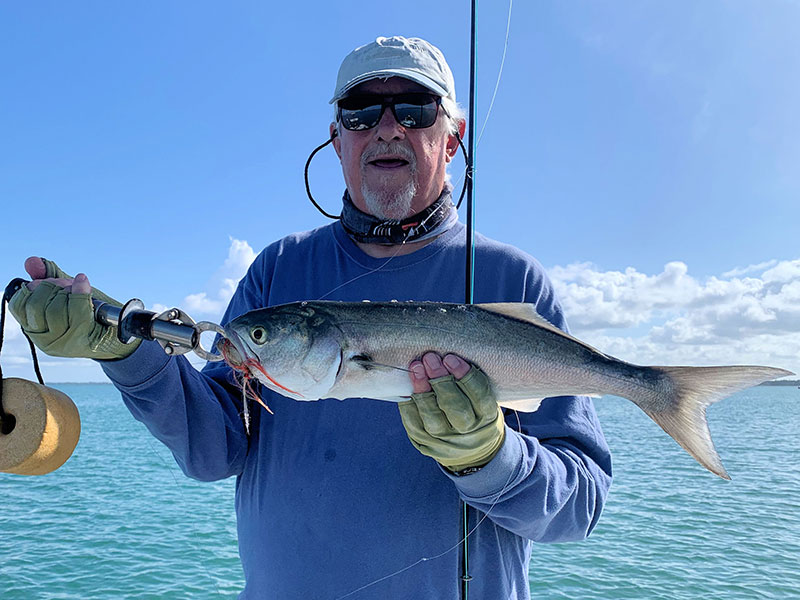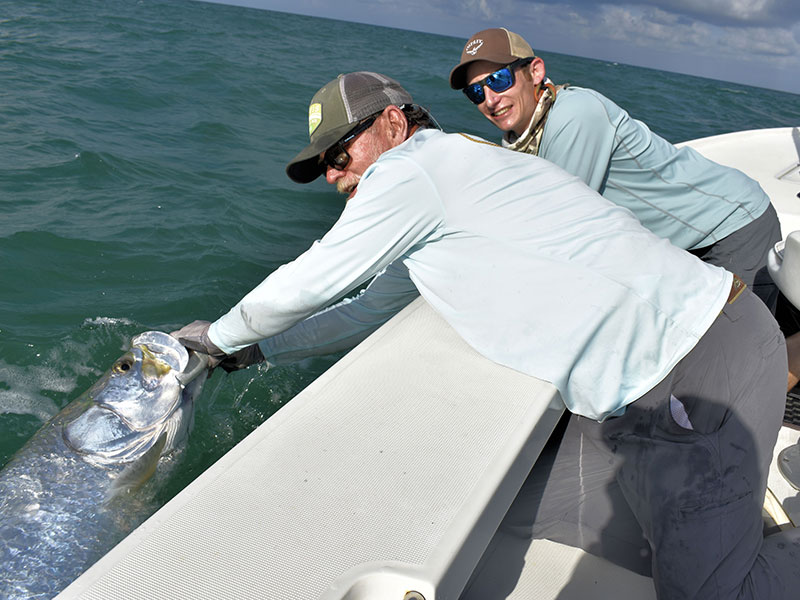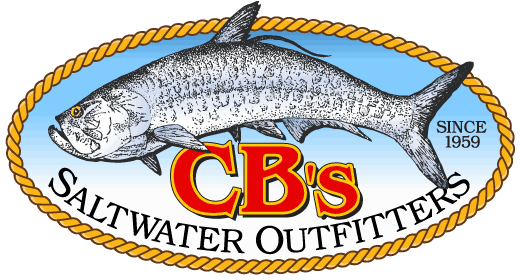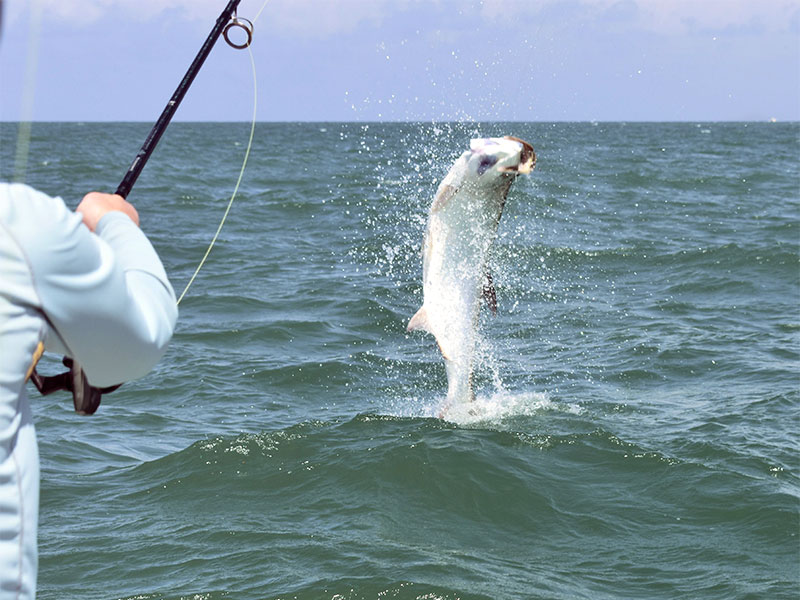Tarpon should be plentiful in the coastal gulf this month as big schools of fish migrate along our beaches. Also look for cobia, tripletail and false albacore (little tunny) in the coastal gulf. Catch and release snook fishing should also be good in and around passes and in the surf. Fishing for a variety of species should also be good on deep grass flats.
Tarpon fishing should be good during June as schools of fish increase in size and numbers. They will head off shore to spawn, close to new and full moons. I’ve done well with Lefty’s Deceiver and my Grassett Flats Bunny fly patterns fished on floating fly lines. Stake out or anchor in travel lanes to get shots at them. Tarpon are creatures of habit and will travel on the same edges and depth contours. The shallower the water, the easier it is to get you fly in front of a tarpon when fly fishing. Since fish may be moving both north and south, setting up within several hundred yards of another angler may negatively affect their fishing. Fly fishing for tarpon is very dependent on conditions and there are a lot of variables that need to come together to be successful.
You should find snook in the surf, in passes and around docks and bridges in the ICW near passes. You can walk the beach and sight fish them in the surf with fly tackle. Small baitfish fly patterns, like Gibby’s DT Special or my Grassett Snook Minnow, should work well. Many of the same flies that work in the surf will also work well at night. Snook will congregate in passes around the new and full moons to spawn, so docks and bridges close to passes will usually hold more fish this time of year.
Fishing for reds should also be good in June. Look for them over shallow grass, along mangrove shorelines or around oyster bars when the tide is high. You’ll find them in potholes or edges of flats when the tide is low. Fly anglers should score with baitfish fly patterns like my Grassett Flats Minnow or Gurglers.
You may find trout, Spanish mackerel, bluefish or pompano on deep grass flats this month. I like to drift and cast ahead of my drift with Ultra Hair Clouser flies tied on long shank hooks on an intermediate sink tip fly line. You’ll need to add a few inches of heavy (40 or 50-pound) fluorocarbon when toothy fish are in the mix. Look for deep grass flats with a mix of grass and sand and a good tidal flow for the best action.
In addition to tarpon look for Spanish mackerel, false albacore, cobia and tripletail in the coastal gulf this month. Although none of them may be thick, I’ve encountered all of them before in June. Keep your eyes open for bird activity or “breaking” fish to find albies and mackerel. Cobia and tripletail may be found around crab trap floats; however I’ve seen cobia swimming with tarpon schools before. An 8 or 9-weight fly rod with a floating or clear sink tip fly line is adequate to catch everything except a big cobia, in which case your 12-weight tarpon fly tackle will work well.
There are lots of options in inshore waters or the coastal gulf this month. If pulling on a 100-pound plus tarpon isn’t for you, fishing pressure is usually light inshore this month so reds, snook, trout and more will also be good options.
Our natural resources are under constant pressure from red tides fueled by industrial, agricultural and residential runoff, freezes, increasing fishing pressure and habitat loss and degradation, please limit your kill, don’t kill your limit!
Tarpon should be plentiful in the coastal gulf this month as big schools of fish migrate along our beaches. Also look for cobia, tripletail and false albacore (little tunny) in the coastal gulf. Catch and release snook fishing should also be good in and around passes and in the surf. Fishing for a variety of species should also be good on deep grass flats.
Tarpon fishing should be good during June as schools of fish increase in size and numbers. They will head off shore to spawn, close to new and full moons. I’ve done well with Lefty’s Deceiver and my Grassett Flats Bunny fly patterns fished on floating fly lines. Stake out or anchor in travel lanes to get shots at them. Tarpon are creatures of habit and will travel on the same edges and depth contours.
The shallower the water, the easier it is to get you fly in front of a tarpon when fly fishing. Since fish may be moving both north and south, setting up within several hundred yards of another angler may negatively affect their fishing. Fly fishing for tarpon is very dependent on conditions and there are a lot of variables that need to come together to be successful.

Bill Morrison, from Holmes Beach, FL, with a bluefish caught on a fly while fishing Sarasota Bay with Capt. Rick Grassett in a previous June.
You should find snook in the surf, in passes and around docks and bridges in the ICW near passes. You can walk the beach and sight fish them in the surf with fly tackle. Small baitfish fly patterns, like Gibby’s DT Special or my Grassett Snook Minnow, should work well. Many of the same flies that work in the surf will also work well at night. Snook will congregate in passes around the new and full moons to spawn, so docks and bridges close to passes will usually hold more fish this time of year.
Fishing for reds should also be good in June. Look for them over shallow grass, along mangrove shorelines or around oyster bars when the tide is high. You’ll find them in potholes or edges of flats when the tide is low. Fly anglers should score with baitfish fly patterns like my Grassett Flats Minnow or Gurglers.
You may find trout, Spanish mackerel, bluefish or pompano on deep grass flats this month. I like to drift and cast ahead of my drift with Ultra Hair Clouser flies tied on long shank hooks on an intermediate sink tip fly line. You’ll need to add a few inches of heavy (40 or 50-pound) fluorocarbon when toothy fish are in the mix. Look for deep grass flats with a mix of grass and sand and a good tidal flow for the best action.
In addition to tarpon look for Spanish mackerel, false albacore, cobia and tripletail in the coastal gulf this month. Although none of them may be thick, I’ve encountered all of them before in June. Keep your eyes open for bird activity or “breaking” fish to find albies and mackerel. Cobia and tripletail may be found around crab trap floats; however I’ve seen cobia swimming with tarpon schools before. An 8 or 9-weight fly rod with a floating or clear sink tip fly line is adequate to catch everything except a big cobia, in which case your 12-weight tarpon fly tackle will work well.

Dan Reinhart, from VT, fights a tarpon that he caught and released while fishing the coastal gulf with Capt. Rick Grassett in a previous June.
Fishing for reds should also be good in June. Look for them over shallow grass along mangrove shorelines or around oyster bars when the tide is high. You’ll find them in potholes or edges of flats when the tide is low. Top water plugs will work well, especially early in the day. I like to cover water with CAL jigs and shad tails or jerk worms to find them. Fly anglers should score with baitfish fly patterns like my Grassett Flats Minnow.
You may find Spanish mackerel, bluefish or pompano in passes or on deep grass flats this month. I like to drift deep grass flats and cast ahead of my drift with CAL jigs and shad tails or jerk worms or DOA Deadly Combos. Fly anglers should score by drifting and casting ahead of the drift with Ultra Hair Clouser flies tied on long shank hooks on an intermediate sink tip fly line. You’ll need to add a few inches of heavy (40 or 50-pound) fluorocarbon when toothy fish are in the mix.
In addition to tarpon look for Spanish mackerel, false albacore, cobia and tripletail in the coastal gulf this month. Although none of them may be thick, I’ve encountered all of them before in June. Keep your eyes open for bird activity or “breaking” fish to find albies and mackerel. Cobia and tripletail may be found around crab trap floats; however I’ve seen cobia swimming with tarpon schools before. Medium spinning tackle and a DOA Shrimp or CAL jig will get the job done for all of them, although your tarpon tackle would also work well for a big cobia. An 8 or 9-weight fly rod with a floating or clear sink tip fly line is adequate to catch everything except a big cobia, in which case your 12-weight tarpon fly tackle will work well.
There are lots of options in inshore waters or the coastal gulf this month. If pulling on a 100-pound tarpon isn’t for you, fishing pressure is usually light inshore this month so snook, reds, trout and more should also be good options.
Our natural resources are under constant pressure from red tides fueled by industrial, agricultural and residential runoff, freezes, increasing fishing pressure and habitat loss and degradation, please limit your kill, don’t kill your limit!




